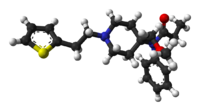Sufentanil
 | |
 | |
| Clinical data | |
|---|---|
| Routes of administration | Injection |
| ATC code | |
| Legal status | |
| Legal status | |
| Pharmacokinetic data | |
| Elimination half-life | 265 minutes |
| Identifiers | |
| |
| CAS Number | |
| PubChem CID | |
| DrugBank | |
| CompTox Dashboard (EPA) | |
| ECHA InfoCard | 100.168.858 |
| Chemical and physical data | |
| Formula | C22H30N2O2S |
| Molar mass | 386.552 g/mol g·mol−1 |
| Melting point | 97 °C (207 °F) |
Sufentanil (Brand Name; Sufenta) is a powerful synthetic opioid analgesic drug, approximately 5 to 10 times more potent than it's analog, Fentanyl. Sufentanil is marketed for use by specialist centres under different trade names, such as Sufenta and Sufentil (India, by Claris Lifesciences Ltd.). Sufentanil was synthesised at Janssen Pharmaceutica in 1974.
Uses
The main use of this medication is in operating suites and critical care where pain relief is required for a short period of time. It also offers properties of sedation and this makes it a good analgesic component of anaesthetic regimen during an operation. It is usually administered under the doctor's order through an intravenous route. In some countries sufentanil is only indicated for epidural use. Despite this, it is often used off-label both intravenously and intranasally. A transdermal sufentanil patch called Transdur-sufentanil is currently in Stage I clinical trials by ENDO pharmaceuticals for the relief of chronic pain, and has the advantage over fentanyl patches such as Duragesic of only needing to be applied once per week.
Side effects
It is essential for the administering doctor to be trained in airway management with readily available airway equipment because the drug causes significant respiratory depression and may cause respiratory arrest if given too rapidly or in too high a dose. Other opioid side effects such as heart rhythm irregularity, blood pressure changes and nausea/vomiting can also be present in patients given this drug and should be dealt with accordingly by the doctor or anesthetist.
Recreational use
Although rare, sufentanil is sometimes encountered on the black market. Its increased potency compared to fentanyl makes it a more attractive product than fentanyl for clandestine chemists as well as drug users. In the United States, it is typically sold in powder form, often combined with cocaine, essentially a speedball prepared in advance; it is usually injected but may be insufflated as well.[citation needed] With the development of NanoTab (a new tablet containing a combination of sufentanil and triazolam), black market abuse can be expected to rise.
Like all fentanyl derivatives, sufentanil is a controlled substance (Schedule II in the United States)
External links
- ^ "FDA-sourced list of all drugs with black box warnings (Use Download Full Results and View Query links.)". nctr-crs.fda.gov. FDA. Retrieved 22 Oct 2023.
